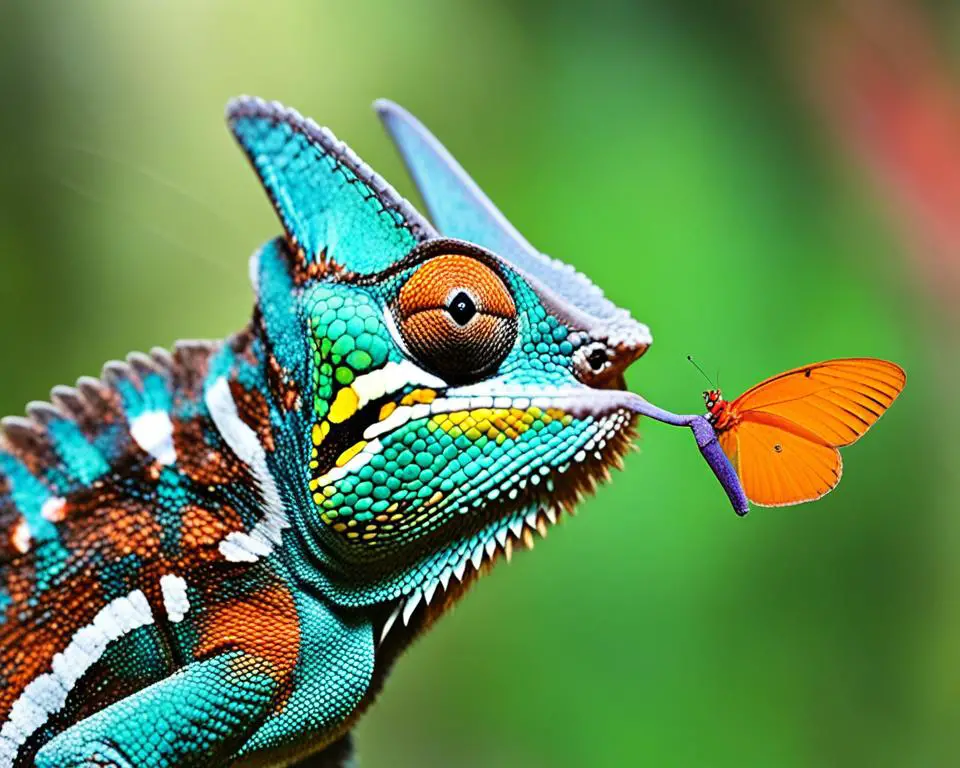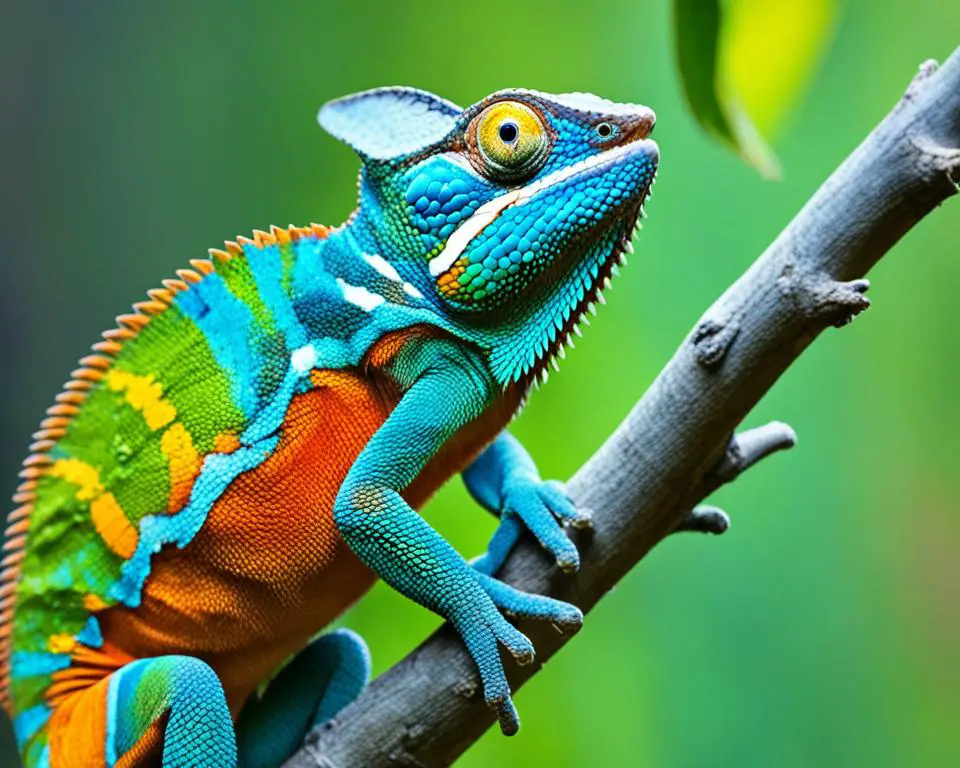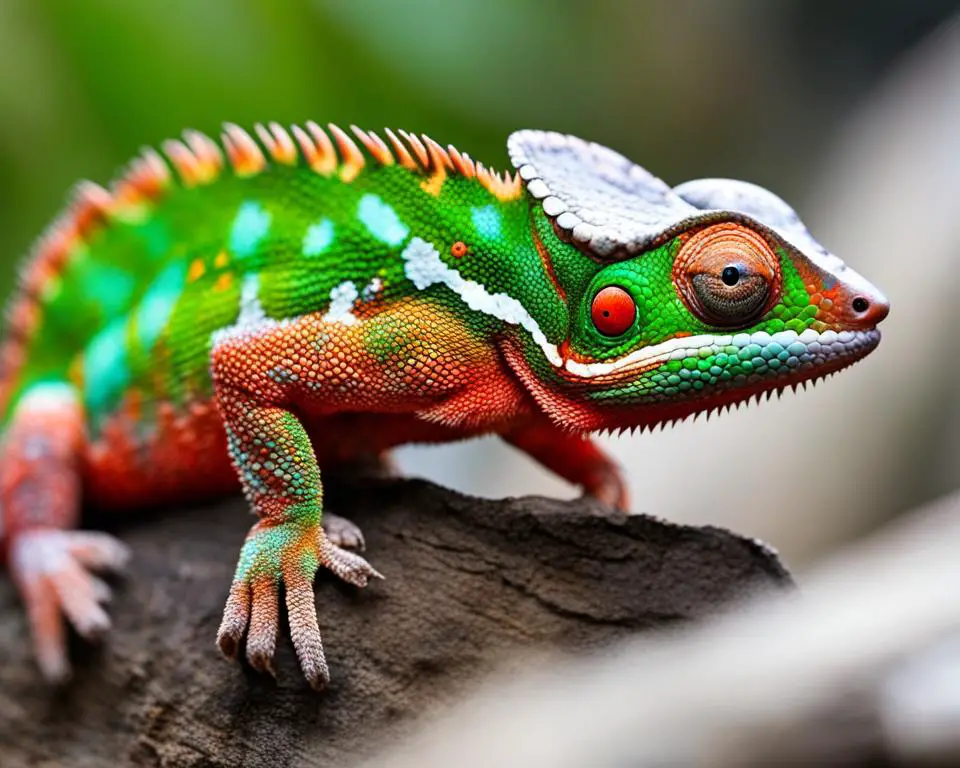Did you know that chameleons are among the most visually stunning and unique reptiles on the planet? These fascinating creatures are known for their amazing abilities and distinct chameleon characteristics, which include far more than just their legendary color-changing skills. In truth, chameleons possess a great deal of adaptability, allowing them to thrive in various environments with ease.
Whether you’re an avid reptile enthusiast or just curious about the natural world, uncovering the secrets behind these adaptable lizards is sure to intrigue you. Their vibrant color transitions are not merely for show; they’re integral to communication and survival in their diverse habitats. So, get ready to learn just what makes chameleons so remarkable!
The Unique Color Changing of Chameleons
Have you ever marveled at a chameleon’s color transformation? Unlike the common misconception, these striking color changes are less about disguise and more about communication and response to the chameleon’s surroundings, including mood, climate, and social interactions. Chameleons display a remarkable palette to the world, serving as both vibrant mood indicators and communication signals essential to their social livelihood.
Imagine a creature whose skin dances with colors reflecting its internal emotions and physical states. This is the reality for chameleons, whose innate abilities for color transformation go hand in hand with highly specialized cells known as iridophores. These cells play a crucial role in chameleons’ ability to absorb and reflect various colors of light, flaunting hues that signal everything from receptivity to a potential mate to aggression towards competitors.
Chameleons have evolved this chameleon communication method as a versatile tool. It acts as a dynamic billboard that changes in real-time, showcasing their mood and intentions to others of their kind. From fiery reds and oranges signaling combativeness to the calm greens and blues signaling contentment, each color conveys a unique message within the chameleon community.
But that’s not all—these color changes also cleverly regulate their body temperature. On a warm sunny day, a chameleon might shift to lighter tones to reflect the heat, while cooler days could see them turn to darker shades to soak in the much-needed warmth.
“Chameleons are indeed artists of the animal kingdom, painting their bodies with colors that speak louder than words.” – Biologist reflecting on chameleon communication.
- Expression of Moods: Watch for vibrant color changes to gauge a chameleon’s emotional state.
- Mating Rituals: Witness males flaunt striking shades during breeding seasons for courtship.
- Health Indicators: Note subdued or intense colors as potential signs of a chameleon’s well-being.
- Thermoregulation: Observe color adaptations as chameleons navigate environmental temperatures.
Lean in closer to any chameleon’s display, and you’ll see nature’s own mood ring at work, a spectacle that never ceases to astonish both the casual observer and the avid herpetologist alike. Step into their world, and you’ll unlock a fascinating realm where color does more than charm—it communicates, protects, and even regulates the life of one of Earth’s most captivating inhabitants.
A Closer Look at Chameleon Habitats
Imagine walking through the lush forests of Madagascar—the sound of leaves rustling in the gentle breeze, the warm sunlight filtering through the canopy. It is in these rich, unique ecosystems you’ll find the quintessence of biodiversity, including over half of the world’s chameleon species. When you hear Madagascar chameleons, think of a place thrumming with life, a symphony of endemic species exclusive to this island.
As you look up into the trees, you’re peering into the abode of an arboreal master. Here, the chameleons exhibit their remarkable arboreal lifestyle, and trees are not just part of their environment; they are their homes, their hunting grounds, and their sanctuary.
Island Dwellers: A Madagascar Exclusive
Madagascar is not just an island; it’s a haven for a multitude of creatures that live nowhere else on Earth. The island’s chameleons, from the impressive Parson’s chameleon to the tiny Brookesia micra, add to the tapestry of life that makes Madagascar a focal point for conservation efforts and scientific curiosity. Their survival amidst this unique biodiversity is a testament to the island’s critical role in nurturing these endemic species.
Tree-Huggers: Life Above Ground
Evolving with the island’s flora, chameleons have become adept climbers, with adaptations that support a life spent in the foliage. Their zygodactyl feet—with two toes facing forward and three back—form natural pincers, perfect for gripping branches. Add to this their prehensile tails, able to coil securely around twigs and branches, and you’ve got a reptile perfectly outfitted for life above ground. Their toe configurations and tail’s ability to act as a fifth limb make them not just survivors, but thrivers in their elevated homes.
“The jungle is their playground, and the canopy, their castle. Madagascar’s chameleons are a true testament to the island’s evolutionary wonder.” – Wildlife Biologist
Their habitat is a crucial aspect of the unique ecosystems they live in, beyond Madagascar’s shores. The same arboreal lifestyle is essential for the survival of chameleon species found in other tropical regions, like sub-Saharan Africa and dense rainforests. These environments provide similar vertical havens for the vertical voyagers—each tree, a new opportunity; each branch, a path to discovery.
In understanding these creatures, you, as a wildlife aficionado, not only gain insight into their world but also the importance of protecting the environments they depend on. The emerald isles and verdant jungles where chameleons rule aloft are not just habitats; they’re irreplaceable realms in which the delicate balance of life must be preserved.
Chameleons: Solitary yet Sociable?
At first glance, chameleons may appear to be the quintessential solitary reptiles, largely due to their preference for a life of seclusion. These remarkable creatures exemplify independence, managing most aspects of their lives without the need for companionship. Despite this predilection for solitude, there are moments when chameleons engage in impressive displays of chameleon social behavior, particularly during the mating courtship.
It’s during the breeding season that male chameleons break out of their solitary shell and enter the social arena. They adorn themselves with striking, ornamental horns and spikes not only to ward off rivals but also to draw the attention of potential mates. This period marks a fascinating departure from their usual behavior, revealing a complex system of communication through dynamic color changes – a vital aspect of their social interactions. Mating courtship is a crucial event that punctuates their otherwise isolated lives.
Outside of this crucial breeding season, chameleons revert to their preferential state of isolation. They avoid direct contact with other chameleons, maintaining their status as solitary reptiles. Their solitary nature ensures minimal conflict over resources and territory, an arrangement that has served them well in the wild.
| Behavior | During Mating Season | Outside Mating Season |
|---|---|---|
| Sociability | Engages with other chameleons for courtship | Minimal to no interaction |
| Display Traits | Bright colors, ornamental features | Cryptic colors, fewer displays |
| Role of Color | Social signaling, attracting mates, deterrence | Regulation of body temperature, camouflage |
As we come to understand the complexities of chameleons’ behavior, it becomes evident that these creatures, though predominantly fond of solitude, have intricate protocols for interaction when it truly matters.
“Stepping into the social sphere only on rare occasions, chameleons are a prime example of nature’s balance between solitude and sociability.”
Take a moment to observe chameleons during their mating season, and you may just witness the rare spectacle of these solitary reptiles transforming into sociable beings, all in the quest for companionship and continuity of their lineage.
Diverse Diets of Chameleons
Discover the fascinating world of chameleons and their exceptional feeding strategies. With an insectivorous diet as their foundation, these charismatic lizards have evolved to expand their culinary preferences to exhibit omnivorous habits. The ability of these reptiles to adapt to a variety of food sources is as diverse as the many species themselves. They engage in prey capture with unparalleled stealth and speed in their natural ecosystems.
Witness the precision of their hunt; chameleons strategically deploy their long, lightning-fast tongues to secure a meal. The sticky tip of their tongue makes short work of ensnaring insects such as crickets and locusts, as well as other small creatures that might cross their vibrant path. Now, imagine the larger types of chameleons, which can consume a staggering number of prey daily, showcasing a remarkable example of their prolific hunting methodology.

It’s not just about the insects though; chameleons sometimes complement their diet with the occasional leaf or fruit, taking omnivorous habits to new heights among reptilian species.
| Chameleon Type | Preferred Insects | Supplemental Diet |
|---|---|---|
| Small Forest Chameleon | Flies, beetles | Plant shoots, berries |
| Large Desert Chameleon | Grasshoppers, large crickets | Dried foliage, seeds |
“These adept hunters, with their extraordinary tongues and versatile diets, capture not just their prey but also our fascination.” – Reptile Enthusiast
- Astonishing prey capture speed
- Diet ranges from strictly insects to including vegetation
- Adaptable hunting techniques across various species
The intricate dance of prey capture by chameleons not only illustrates their mesmerizing physical prowess but also their inherent ability to adapt to what their environment offers for sustenance. As you delve deeper into the lush habitats these creatures call home, their feeding practices reveal just how in tune they are with the circle of life.
The Art of Camouflage: More Than Meets the Eye
Delve into the world of chameleons, where camouflage extends far beyond simple hide-and-seek. In their natural environments, these remarkable reptiles exhibit colors that remarkably echo the hues of their immediate surroundings—thanks to their distinctive natural habitat colors, these creatures seamlessly blend with the verdant greens, earthy browns, and dusty tans of the foliage and terrain.
Understanding the truth behind a chameleon’s ability to change color offers insights into their survival: it’s a multifunctional tool used for predator defense, prey capture, and even more subtle aspects of existence such as stress indicators and thermal regulation. Contrary to popular belief, the interplay of colors in a chameleon’s skin is a complex visual language filled with social cues, rather than a mere adaptation for concealment.
A Natural Fit: Matching Surroundings
Chameleons are naturally equipped with a dynamic wardrobe that echoes the very essence of their habitations. This innate wardrobe is not about constant color changes but rather about an inborn palette perfect for the art of masquerade, allowing these creatures to become one with leaves and branches, aiding significantly in their predator defense mechanisms and prey capture strategies.
Color Changes: More Than Just for Hiding
When a chameleon’s skin darkens or lightens, it’s speaking volumes. The darker colors can be stress indicators, or perhaps they’re absorbing heat for thermal regulation. Lighter shades, conversely, serve to deflect unwanted warmth. What we witness in these rapid shifts is a creature superbly attuned to its environment, crafting a living barometer of well-being and intent through color.
As you observe these enchanting reptiles, remember that their camouflage is their language—a language that speaks of emotion, environment, and a rich social life, tightly woven into the fabric of their survival. So the next time you see a chameleon change color, know that you’re not just witnessing camouflage in action but a symphony of survival strategies playing out in living color.
Anatomy of a Chameleon: Eyes, Tongue, and Toes
As a testament to the wonders of natural selection, chameleons boast an array of specialized features fine-tuned for their survival. Their unique anatomy is not just fascinating to observe—it’s a set of chameleon adaptations that allows these lizards to navigate the complex environments in which they live.
Let’s start with their eyes. Chameleons have bulging eyes that grant them near 360-degree vision. This incredible feature allows them to keep an eye out for predators and prey, all without moving their heads. Just imagine being able to see almost everything around you—what a phenomenal panoramic view!
Their tongues, another remarkable asset, can catapult out to capture prey at lightning speeds. These elongated appendages can stretch to twice the length of their body, snapping up unsuspecting insects in the blink of an eye. It’s not just about length; their tongues are equipped with powerful muscles and a bone structure that provides deadly accuracy.
Now, picture yourself navigating the treetops with the grace of a chameleon. It’s their zygodactylous toes that make it possible. These toes are grouped in a way that enhances their grip, allowing these creatures to clasp onto branches with ease. Each foot is a marvel of engineering, perfectly designed for an arboreal lifestyle.
| Feature | Anatomical Detail | Adaptation Purpose |
|---|---|---|
| Eyes | Bulging, independently mobile | Wide range of vision for predator and prey detection |
| Tongue | Lengthy and sticky, with muscles and bones | Snatching prey with precision and speed |
| Toes | Zygodactylous, grouped for gripping | Facilitating grip on branches for agile movement |
Marveled by these remarkable creatures? You’re not alone. The intricate design of their eyes, tongue, and toes bears the signature of millions of years of evolution. It’s a unique combination of characteristics that underpins the chameleon’s mastery over its domain—making the chameleon not just a creature of curiosity but a representation of nature’s ingenuity.
Fun Facts About Chameleons: The Feline-Sized Chameleon
When you delve into the world of chameleon species, you’ll be amazed by the size variation they exhibit. From the grandeur of the Parson’s chameleon, which can measure up to an impressive length akin to your typical house cat, to the petite Brookesia micra, which is so small it’s capable of balancing atop a match head with ease.
This staggering range in size among chameleons is not just a trivial fact; it reflects the immense adaptability and diversity within these fascinating creatures. Each species has honed its growth to fit perfectly within a designated niche in the ecosystem, whether that be the sprawling branches above or the leaf-littered forest floor below.
| Chameleon | Size Comparison | Habitat Preference |
|---|---|---|
| Parson’s Chameleon | Comparable to a house cat | Tree canopies in eastern Madagascar |
| Brookesia Micra | Sits on a match head | Leaf litter of Madagascar islets |
These extremes in body size among chameleon species also serve a purpose beyond fitting into environmental niches. The larger Parson’s chameleon, with its formidable size, can dominate more territory and visually impress potential mates. In contrast, the minuscule Brookesia micra takes advantage of its diminutive stature to conceal itself from predators and to thrive in a micro-habitat that larger creatures simply cannot exploit.
- Understand that the size variation in chameleons is symbolic of their evolutionary success in occupying a wide array of ecological niches.
- Observe how the Parson’s chameleon‘s size may offer advantages both in survival and reproduction within its species.
- Acknowledge the Brookesia micra’s unique adaptability that its small size affords in evading predation and occupying unique microenvironments.
As you explore the wonders of chameleons, remember that their size tells a story of adaptation and survival. Truly, these enigmatic creatures are an ode to the marvels of evolution, as seen in the astonishing range of their sizes.
Not Just for Looks: Chameleons’ Bulging Eyes
When you gaze into the striking, bulbous eyes of a chameleon, you’re looking into a sophisticated visual system unparalleled in the reptile world. This unique feature isn’t just about giving these creatures a distinctive appearance; it’s a crucial element for their survival, providing a panoramic view and precise vision that ensures they stay one step ahead in the wild.
A Unique Perspective: 360 Degree Vision
The ability to maintain an almost complete panoramic view of their surroundings gives chameleons an exceptional level of environmental awareness. This complete visual coverage allows them to monitor a vast range with little movement, significantly reducing the chances of a predator catching them off-guard. It’s a powerful survival tactic in the unpredictable world they inhabit.
Independent Focus: Hunting and Survival
Chameleons’ eyes can move independently, enabling a dual focus that few other species possess. This capacity for independent operation allows them to keep an eye on an advancing threat while simultaneously readying themselves to ambush unsuspecting prey. The predatory advantage gained from such precise control is a testament to their evolved hunting strategies and key to their survival.
Their eyes function in unison when it’s time to strike, converging their fields of vision for a precise lock on their target. The survival tactics of chameleons are not just about escaping predators, but also ensuring that they master their hunting ground with precision and efficiency.
“The extraordinary eyes of a chameleon are the perfect blend of beauty and functionality, crafting a visual experience that’s as vital as it is impressive.”
The Power of a Chameleon’s Tongue
The chameleon’s tongue is a marvel of nature, exemplifying feeding adaptation at its most extreme. This exceptional appendage confers upon the chameleon a number of advantages, key among them being tongue acceleration and prey snatching, which contributes to their hunting efficiency in the wild. Let’s take a closer look at the intricate details of how this incredible feature works.
Speed and Accuracy: Insect Catching Mastery
Known for its tactical ambush tactics, a chameleon’s tongue strike is a case study in predatory precision. The speed at which the tongue launches and retracts is the result of intense muscle tongue acceleration, allowing these reptiles to catch their prey virtually unnoticed. Such rapid movement ensures an impressively high catch rate, as the unsuspecting prey has little to no time to react or escape.
The level of accuracy this mechanism involves is equally as fascinating. Chameleons can accurately gauge the distance to their target, adjusting their tongue’s trajectory mid-launch. This astonishing accuracy underscores the chameleon’s place as a master of prey snatching. The split-second it takes for the tongue to make contact with the target is all a chameleon needs to secure a meal.
Length Matters: Tongues Longer Than Bodies
Adding to their predatory arsenal is the remarkable tongue length. In some species, the length of the chameleon’s tongue actually surpasses its own body length. This extraordinary body proportion creates an extensive reach, allowing them to snag prey from a distance that would seem safe from such a predator. This adaptation maximizes their food acquisition opportunities and illustrates a stunning example of evolutionary innovation in the reptile kingdom.
As you watch a chameleon in action, it’s clear that its tongue is a highly specialized tool, perfectly designed for its ecological niche. Whether replenishing its energy with rapid insect meals or reaching for sustenance across physical barriers, the chameleon’s tongue is a testament to its survival and feeding adaptation in diverse environments.
- Explosive muscle movement for high-speed strikes
- Pinpoint accuracy for effective capture
- Extended length for increased hunting range
The next time you see a chameleon, take a moment to appreciate the lightning-fast action that unfolds in the blink of an eye—a masterful feat of evolution and adaptation that ensures the chameleon remains an apex predator within its realm.
Mating Rituals and Color Displays
When it’s time for chameleons to engage in their reproductive behavior, their bodies become canvases for intricate signaling displays. As you observe these creatures, you’ll see a stunning array of colors that communicate much more than you might expect. These vibrant transitions are essential chameleon interactions during the mating season and play an integral role in chameleon courtship.

Males in particular use these bright colorations as part of their mating rituals to attract females. Their colorful displays are not just for attraction; they serve as bold statements of health and vitality, proving their worthiness as mates. Concurrently, these same displays can intimidate potential rivals, keeping competitors at bay and ensuring the signaling male’s dominance.
Females, on the other hand, have their own unique way of utilizing color as part of their reproductive cycle. Depending on their readiness to mate, the colors they exhibit can either welcome advances or signal a staunch refusal. This dichotomy in the presentation is a direct communication to the males, informing them of her mating decision without the need for direct interaction.
- Brighter hues from males can signify an invitation to mate or an alert of territorial claim.
- Females’ subdued tones often indicate a lack of interest in mating, while vibrant ones may signal receptiveness.
- Dramatic changes in color during chameleon interactions can escalate quickly, often culminating in a flurry of competing displays among rivals.
These color displays, so prominent during the mating season, fade back into the day-to-day camouflage once the interactions have concluded. Yet, the memory of the striking colors that fill the chameleon’s world during this vibrant time remains an illustrious example of nature’s flair for dramatic signals.
| Reproductive State | Male Color Display | Female Response |
|---|---|---|
| Seeking a Mate | Dynamic, vivid hues | Varies between receptive bright patterns and non-receptive subdued colors |
| Maintaining Territory | Bold, intimidating patterns | N/A |
| Combat with Rivals | Aggressive color flashes | N/A |
Witnessing these natural spectacles of chameleon interactions gives you a glimpse into the complexities of chameleon social rituals—where every color and shade has a purpose. It’s a dance of hues that weaves the fabric of their very survival and continuation of species. So next time you see a chameleon, look beyond the color; you’re looking at a language, an interaction, and a lifestyle that’s uniquely theirs.
Chameleons as Pets: Considerations and Care
Embracing the world of chameleon pet care brings its own unique set of delights and challenges. As alluring as their kaleidoscopic changes may be, responsible pet ownership means understanding the full spectrum of their needs. Chameleons are not your typical pet; they require controlled environments that closely mimic their natural habitats to thrive in captivity.
Understanding Their Needs: Creating a Proper Habitat
Your quest to create a sanctuary for your chameleon begins with meticulous attention to habitat requirements. Temperature, humidity, and lighting must be carefully controlled to simulate the tropical climate they are accustomed to. A terrarium with ample space for climbing will allow your chameleon to exhibit natural behaviors, vital for their overall well-being and sanity.
“Crafting a miniature jungle within your home isn’t just about aesthetics; it’s about providing your chameleon with the necessary resources to flourish – temperature gradients, basking spots, and seclusion areas,” says a renowned reptile expert.
But replicating their environment goes beyond the physical setup—diet, hydration, and proper sanitation are equally critical components of effective chameleon care.
Challenges of Captivity: Health and Behavior Considerations
Beneath their enigmatic exterior, chameleons are sensitive creatures and can suffer from captive stress if their care is mishandled. They are prone to ailments such as metabolic bone disease and respiratory infections if the habitat’s temperature and humidity levels are inconsistent. Observant owners must act as guardians, preemptively identifying any health issues and seeking veterinary advice.
Understanding a chameleon’s behavior is integral in mitigating stress—recognize that these are not pets to be handled frequently. Their social interactions vastly differ from mammals; they communicate through subtle movements and color changes, not through touch. The less you handle them, the happier they tend to be.
Here’s a simple table to help you visualize what a chameleon’s habitat should include:
| Requirement | Examples | Purpose |
|---|---|---|
| Vertical Space | Tall terrarium, plants, branches | Allows for climbing and exploration |
| Temperature Control | Basking lamps, thermometers | Mimics natural heat gradients |
| Humidity | Misting systems, hygrometers | Replicates tropical moisture levels |
| UV Lighting | UVB bulbs | Essential for Vitamin D3 synthesis |
| Diet | Live insects, occasional plants | Provides balanced nutrition |
In committing to the stewardship of a chameleon, remember that your vigilance and dedication to recreating their natural world can make all the difference in fostering a content and healthy pet. Your role is not just as a caretaker but as a custodian of a piece of the wild—right within your home.
Conservation Status: Addressing the Chameleon’s Plight
Strolling through the world’s forests and grasslands, you might not immediately spot a chameleon, for this reptile is the master of subtlety. Yet, despite their concealed nature, chameleons are encountering visibility in a way they never intended—many species are now listed as endangered due to pressing threats to their existence. Your understanding of these threats is critical for the improvement of biodiversity protection methods.
The conversation around chameleons often sparkles with fascination toward their vibrant colors and peculiar hunting tactics. However, we must shift our focus to the darker shades of the narrative: habitat loss and the encroaching dangers posed by human expansion. To combat these threats, conservationists are advocating for sustainable land development and stricter regulations on the exotic pet trade.
Imagine lush landscapes being diminished to wastelands, stripping chameleons of their homes. Deforestation not only robs them of shelter but also decimates their food sources, making survival an ever-steepening uphill battle. Each chameleon lost is a stroke erased from the rich canvas of life upon which our planet’s health depends.
“Every chameleon sings an ecological aria, and when silenced, it’s an irreplaceable verse that’s lost in nature’s grand symphony.” – A conservationist on biodiversity loss.
To truly be stewards of these endangered species, you must recognize that adopting a chameleon as a pet is a significant commitment. It means not only providing a simulacrum of their natural habitat but also understanding the ecological impact of removing them from their native environments.
| Conservation Status | Primary Threats | Conservation Actions |
|---|---|---|
| Critically Endangered | Deforestation, Illegal Trade | Protected Areas, Trade Regulations |
| Endangered | Land Development, Climate Change | Environmental Education, Habitat Restoration |
| Vulnerable | Pollution, Non-native Species | Community Engagement, Invasive Species Control |
As a conscious observer, you have the power to influence change. You can do so by supporting organizations focused on biodiversity protection, promoting habitat conservation initiatives, and advocating for the responsible care of these animals within the pet trade.
Arm yourself with knowledge, and let your voice harmonize with those fighting for the conservation of the chameleon. Together, we can reverse the course of their plight and ensure that chameleons continue to thrive for generations to come.
Conclusion
As we draw this exploration to a close, your journey through the vibrant life of chameleons has, undoubtedly, illuminated the sheer adaptability of these wonders of the reptile kingdom. Your increased reptile admiration mirrors the collective intrigue they inspire. Importantly, understanding chameleons’ intricate existence does more than satiate curiosity—it accentuates the pivotal role of conservation efforts to ensure the continuity of their species.
Indeed, chameleons are not mere spectacles of color and novelty; they are vital threads in the tapestry of biodiversity. Through environmental education, we learn the significant impact that even the smallest of our scaled friends has on the ecological balance. It is this knowledge that empowers you to make informed decisions, championing habitats conservation and responsible pet ownership. The vibrant future of these enigmatic lizards depends just as much on our advocacy and care as on the leaves and branches they call home.
By fostering an environment where reptile admiration leads to purposeful action, you become part of a larger community aimed at preserving not only chameleons but all wildlife. Remember, each step towards enhancing conservation knowledge and engagement is a leap towards protecting the natural world we treasure. So, let’s carry forward the colorful legacy of chameleons with the respect and dedication they, and all creatures, inherently deserve.










